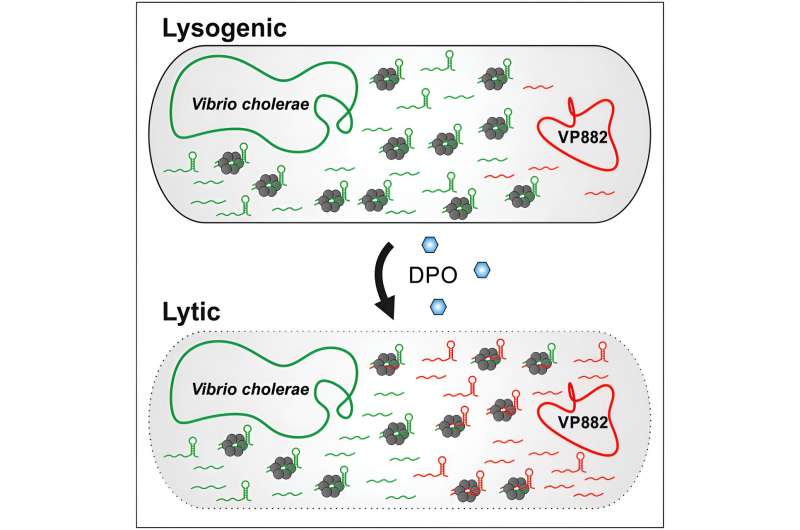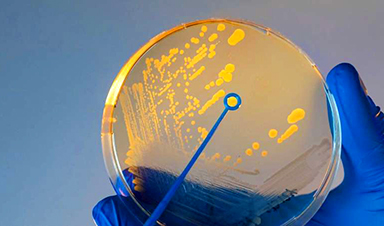Viruses need hosts. Whether it’s measles, the flu or coronavirus, viral pathogens cannot multiply or infect other organisms without the assistance of their hosts’ cellular infrastructure. However, humans are not the only ones affected by viruses: animals, plants and even microorganisms can all serve as hosts.
Viruses that use bacteria as host cells are called bacteriophages (or simply “phages” for short) and are thought to be the most abundant biological entities of all. Just as the human immune system springs into action to resist a flu or coronavirus infection, bacteria do not simply allow phages to infiltrate their cellular machinery without a fight.
A research team at the University of Jena and its Cluster of Excellence “Balance of the Microverse” has examined in detail the complex interaction of attack and defense strategies when cholera-causing bacteria (Vibrio cholerae) are infected with a bacteriophage known as VP882—and discovered that tiny RNA molecules play a decisive role. The researchers’ findings have been published in the latest issue of the journal Cell Host & Microbe.
From harmless housemate to cunning kidnapper
There are two ways in which phages can multiply after infecting bacteria: either as invisible passengers, hidden in the bacteria’s genetic material, or as cunning kidnappers, multiplying in vast numbers in bacterial cells without regard for potential losses and, ultimately, destroying the cells. Which method a phage adopts depends on whether sufficient numbers of other host cells are available in the immediate environment to provide shelter.
But how do phages determine this? “They rely on a chemical counting mechanism that bacteria use to identify other members of their species,” explains Prof. Dr. Kai Papenfort of the University of Jena, who headed up the project.
Known as “quorum sensing,” this method uses signal molecules that are produced by bacteria and released into their surroundings. At the same time, the bacteria monitor the concentration of these molecules using specific receptors, thereby gaining information about the size of their current population.
“The phages’ trick essentially involves ‘listening in’ to this chemical communication between bacteria,” says Papenfort.

In their experiments, the Jena researchers examined what happens to the phages and bacteria once the bacteria emit their quorum sensing signals. “We have observed that 99% of bacteria are destroyed within 60 minutes, in which time the phages take control,” reports Dr. Marcel Sprenger, the lead author of the article.
The team discovered that this switchover is controlled by tiny RNA molecules, one of which is called “VpdS” (VP882 phage-derived sRNA). “As soon as the phages receive the chemical signal from the bacteria, this RNA is produced in high quantities,” says Sprenger.
How bacteria fight back against viruses
In order to find out precisely which genes are regulated by VpdS, the team adopted a comprehensive, technological approach and infected bacteria cultures with both VP882 phages and genetically modified phages unable to produce VpdS.
Applying a method known as “RNA interaction by ligation and sequencing,” the researchers were able to identify the interactions between all RNA molecules in the bacteria cultures at different times. “This not only gave us insights into which genes are active, it also showed how they interact,” says Papenfort.
This method enabled the researchers to examine the genes of the phages as well as those of the host bacteria. As a result, the researchers gained extensive insights into the changes that occurred both during and after quorum sensing. “We were able to demonstrate that VpdS regulates phage genes as well as genes of the host, which effectively explains the destruction of bacterial cells,” says Papenfort.
However, the researchers have been able to deduce further relationships from the data they collected. For example, bacteria also have genes that, when activated by a chemical signal, fight back against the phages’ propagation and thereby counteract their own destruction.
According to Papenfort, this aspect is particularly interesting. “We can see these as the precursors to the immune systems in higher organisms. Bacteria have many genes that protect them against viruses.” Given that these genes are also present in higher organisms, the researchers surmise that RNA molecules could also play an important role in their regulation.
More information: Small RNAs direct attack and defence mechanisms in a quorum sensing phage and its host, Cell Host & Microbe (2024). DOI: 10.1016/j.chom.2024.03.010. www.cell.com/cell-host-microbe … 1931-3128(24)00090-8
Journal information: Cell Host & Microbe
News
Studies detail high rates of long COVID among healthcare, dental workers
Researchers have estimated approximately 8% of Americas have ever experienced long COVID, or lasting symptoms, following an acute COVID-19 infection. Now two recent international studies suggest that the percentage is much higher among healthcare workers [...]
Melting Arctic Ice May Unleash Ancient Deadly Diseases, Scientists Warn
Melting Arctic ice increases human and animal interactions, raising the risk of infectious disease spread. Researchers urge early intervention and surveillance. Climate change is opening new pathways for the spread of infectious diseases such [...]
Scientists May Have Found a Secret Weapon To Stop Pancreatic Cancer Before It Starts
Researchers at Cold Spring Harbor Laboratory have found that blocking the FGFR2 and EGFR genes can stop early-stage pancreatic cancer from progressing, offering a promising path toward prevention. Pancreatic cancer is expected to become [...]
Breakthrough Drug Restores Vision: Researchers Successfully Reverse Retinal Damage
Blocking the PROX1 protein allowed KAIST researchers to regenerate damaged retinas and restore vision in mice. Vision is one of the most important human senses, yet more than 300 million people around the world are at [...]
Differentiating cancerous and healthy cells through motion analysis
Researchers from Tokyo Metropolitan University have found that the motion of unlabeled cells can be used to tell whether they are cancerous or healthy. They observed malignant fibrosarcoma [...]
This Tiny Cellular Gate Could Be the Key to Curing Cancer – And Regrowing Hair
After more than five decades of mystery, scientists have finally unveiled the detailed structure and function of a long-theorized molecular machine in our mitochondria — the mitochondrial pyruvate carrier. This microscopic gatekeeper controls how [...]
Unlocking Vision’s Secrets: Researchers Reveal 3D Structure of Key Eye Protein
Researchers have uncovered the 3D structure of RBP3, a key protein in vision, revealing how it transports retinoids and fatty acids and how its dysfunction may lead to retinal diseases. Proteins play a critical [...]
5 Key Facts About Nanoplastics and How They Affect the Human Body
Nanoplastics are typically defined as plastic particles smaller than 1000 nanometers. These particles are increasingly being detected in human tissues: they can bypass biological barriers, accumulate in organs, and may influence health in ways [...]
Measles Is Back: Doctors Warn of Dangerous Surge Across the U.S.
Parents are encouraged to contact their pediatrician if their child has been exposed to measles or is showing symptoms. Pediatric infectious disease experts are emphasizing the critical importance of measles vaccination, as the highly [...]
AI at the Speed of Light: How Silicon Photonics Are Reinventing Hardware
A cutting-edge AI acceleration platform powered by light rather than electricity could revolutionize how AI is trained and deployed. Using photonic integrated circuits made from advanced III-V semiconductors, researchers have developed a system that vastly [...]
A Grain of Brain, 523 Million Synapses, Most Complicated Neuroscience Experiment Ever Attempted
A team of over 150 scientists has achieved what once seemed impossible: a complete wiring and activity map of a tiny section of a mammalian brain. This feat, part of the MICrONS Project, rivals [...]
The Secret “Radar” Bacteria Use To Outsmart Their Enemies
A chemical radar allows bacteria to sense and eliminate predators. Investigating how microorganisms communicate deepens our understanding of the complex ecological interactions that shape our environment is an area of key focus for the [...]
Psychologists explore ethical issues associated with human-AI relationships
It's becoming increasingly commonplace for people to develop intimate, long-term relationships with artificial intelligence (AI) technologies. At their extreme, people have "married" their AI companions in non-legally binding ceremonies, and at least two people [...]
When You Lose Weight, Where Does It Actually Go?
Most health professionals lack a clear understanding of how body fat is lost, often subscribing to misconceptions like fat converting to energy or muscle. The truth is, fat is actually broken down into carbon [...]
How Everyday Plastics Quietly Turn Into DNA-Damaging Nanoparticles
The same unique structure that makes plastic so versatile also makes it susceptible to breaking down into harmful micro- and nanoscale particles. The world is saturated with trillions of microscopic and nanoscopic plastic particles, some smaller [...]
AI Outperforms Physicians in Real-World Urgent Care Decisions, Study Finds
The study, conducted at the virtual urgent care clinic Cedars-Sinai Connect in LA, compared recommendations given in about 500 visits of adult patients with relatively common symptoms – respiratory, urinary, eye, vaginal and dental. [...]





















